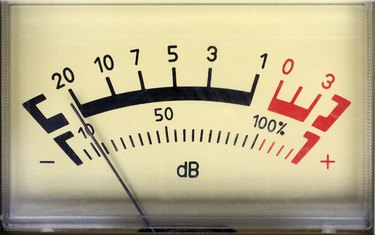
Any computer can be used to measure sound levels, given the correct hardware and software, but the quality of the hardware will determine the effectiveness of the decibel metering. Decibels measure the difference between two levels of power and can be applied to sound, electricity or pressure. For true sound level metering an absolute quiet level must be established so the dB meter can display the ratio of the difference between absolute silence and the sound recorded. Most computers won't be able to do this, but you can still get a general idea of sound levels using a computer microphone or by analyzing an audio recording.
Step 1
Use the Decibel Meter app for Windows 8 (see link in Resources) to measure the ambient noise of a room or environment. The app uses the internal microphone on your computer or tablet and allows you to see, in real time, the volume level of the sound around you along with a reference list of everyday noises and their dB levels.
Video of the Day
Step 2
Monitor and record audio with Audacity (see link in Resources). The dB meter in Audacity references recording levels which are based on the standard of one millivolt. A negative decibel reading in recording software doesn't indicate a lack of sound, but that the sound is producing less than one millivolt of current through the audio equipment.
Step 3
Compare and analyze audio files using the Virtual Sound Level Meter (see link in Resources). You can load in a reference file in WAV format and then compare it to another recorded file. Click "Load Cal WAV" and browse to your calibration file. Click "Load Meas. WAV" and browse to the sound file you want to measure. When you're ready, click "Analyze Data" to see the comparison between the calibration file and the measurement file in dB.
Video of the Day